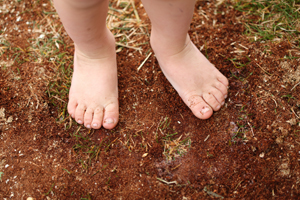 Good soil is one of the most important requirements for a successful organic vegetable garden. In fact, it’s just as crucial as high-quality seeds and plenty of water and sunlight. Here are some tips to make your soil as rich and nutrient dense as possible.
Good soil is one of the most important requirements for a successful organic vegetable garden. In fact, it’s just as crucial as high-quality seeds and plenty of water and sunlight. Here are some tips to make your soil as rich and nutrient dense as possible.
Clear the area of everything you don’t need.
After you’ve decided where to put your garden, it’s time to dig in. Remove any visible rocks, brush, and debris. Rent or borrow a rototiller to turn the soil and outline the general area of the garden. Take your time if you have rocky soil or if it’s the first time you’ve tilled this area—you want to remove all the rocks and buried “stuff” the rototiller turns up. If you’re reawakening an existing garden plot, turn compost into the area using the rototiller.
Test your soil.
Your state or county’s agriculture extension service should provide soil-testing kits. You’ll discover the pH and nutrient levels of your soil so you can use organic soil amendments as necessary. The more nutrient rich your soil is, the more nutrient rich your vegetables will be.
You’ll also want to know how much sand or clay your soil has and how well it drains. Fill a quart glass jar with 1” of soil (about a cup) and 1/4 teaspoon of powdered dishwasher detergent. Fill the jar with water until it is about 2/3 full, and then shake for a minute or two, turning it over to get all the soil off the bottom. Turn it upright, set it on the counter, and start timing:
- After one minute, mark how much has settled at the bottom. This is sand.
- After five minutes, mark how much more has settled. This is silt.
- After an hour, the additional amount that has settled is clay. Mark this so you can see the relative percentages of sand, silt, and clay.
Depending on what the soil tests say, sandy soil will need more organic compost and water, as it tends to be drier and may retain fewer nutrients. Clay-heavy soil will need organic gardening compost to increase aeration but won’t need to be watered often.
To test drainage, dig a hole in dry soil and fill with water. See how long it takes the soil to absorb the water. If the water disappears quickly, you’ll need to water more, and if it sits for quite a while, you won’t have to water as often.
Use the test results to amend your soil.
Based on the tests you’ve performed above, you now know which organic soil amendments are the best choices for your soil. Organic compost such as MOO DOO® or MOO PLUS® will add nutrients to sandy or nutrient-poor soil, while organic topsoil such as MOO DIRT® will help break up the clay in your soil.
Don’t skimp on the amounts compost—you want to treat at least six inches of soil, so you’ll need plenty. Work the soil amendments in by hand or with garden tools, but be careful to do it evenly and go as deeply as you need to.
What are your best tips for preparing soil for an organic vegetable garden?




